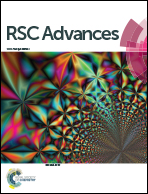Highly rapid and non-enzymatic detection of cholesterol based on carbon nitride quantum dots as fluorescent nanoprobes†
Abstract
In this work, we reported a highly rapid and non-enzymatic method for cholesterol measuring based on carbon nitride quantum dots (CNQDs) as fluorescent nanoprobes, which were synthesized through chemical oxidation. The obtained CNQDs displayed high quantum yield up to 35% as well as excellent photostability, water solubility and low toxicity. We found that the fluorescence of CNQDs could be quenched more than 90% within 30 seconds by cholesterol through the formation of hydrogen bonds between –NH2, –NH on the surface of CNQDs and cholesterol containing –OH. According to this phenomenon, a cholesterol detection method was constructed with a wide linear region over the range of 0–500 μmol L−1 and a detection limit as low as 10.93 μmol L−1, and it possessed the obvious advantages of being a very rapid process and avoiding the use of enzymes. In addition, this method showed high selectivity in the presence of various interfering reagents and applicability to the measurement of cholesterol in fetal bovine serum, which indicated its potential application value in clinical settings.



 Please wait while we load your content...
Please wait while we load your content...